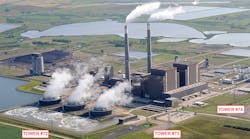There is no such thing as routine transmission tower repair. Every callout is unique. Some are easy while others require more inventive solutions that tax everyone involved with the work. Case in point: Great River Energy recently experienced two unexpected tower issues that required innovative repairs. One incident involved a tractor on autopilot, and the other was a result of 5 inches (12.7 cm) of radial rime ice on shield wires.
Tower repairs can be tricky with multiple moving parts, so extreme caution is required. By thinking outside the box, Great River Energy was able to repair the damage from both incidents safely and efficiently. The utility’s engineers used the latest technology to solve problems creatively.
Ice on the Line
Transmission lines near North Dakota power plants frequently contend with the winter elements. Coal Creek Station is Great River Energy’s largest coal-fired power plant, and transmission lines near it experience ice buildup because the transmission towers are adjacent to the plant’s cooling towers.
In most cases, the ice buildup is rime ice, which is comparable to the density of snow. A formation of frost-like ice crystals builds up on the windward side of the conductor. This buildup enlarges the conductor to several times the normal diameter.
Knowing ice is an issue, Great River Energy engineers developed ice-mitigating operating procedures. The first line of defense is to prevent ice from building up. As most ice forms with freezing temperatures and winds in the range of 20 mph to 40 mph (32 km per hour to 64 km per hour), Great River Energy stops operating one of its cooling towers when these conditions occur. This reduces the amount of condensation on the transmission line.
If ice buildup continues to occur, load cells installed on the conductor near the cooling towers monitor ice accumulation. Once a ½ inch of solid radial ice equivalent is observed by the load cells, an alarm trips and crews are dispatched to switch on an ice melting system that heats up the wires and helps to shed ice.
Following an insulator failure and the establishment of ice-mitigating procedures, there was still a minor structural failure on Tower 72 near the plant in the 1990s. The shield wire arm was retrofitted but inadvertently created a structural instability. This instability was exacerbated by extreme ice loading in December 2016 and led to the most recent failure.
North Dakota Christmas
On Dec. 25, 2016, strong northeast winds and fog began freezing on contact with the wires. Prevention measures were followed, and the cooling tower closest to the line ceased operation. However, the alarm system did not sound because the ice accumulation did not occur on the conductor span with load cells. Therefore, line technicians were not notified to use the ice melting equipment.
Because of the increased load caused by ice accumulation, the modified shield wire arm collapsed on itself. As it collapsed, the wire crossed over and made contact with the top phase of one of the circuits, tripping the line out of service. The adjacent shield wire arm also collapsed but remained outside the conductor arm and did not cause a trip on the second circuit.
At 172 ft (52.4 m) to the top, Tower 72 is one of Great River Energy’s tallest structures. Readily available bucket trucks could not reach that height. The structure also was still covered with ice and would have been dangerous to climb.
Creative Solutions
In lieu of traditional alternatives, an unmanned aerial vehicle (UAV) operator assessed the damage. Based on the UAV footage, engineers determined the structure needed to be stabilized. By relocating the shield wire and securing it to the center of the tower, the structure was stabilized while engineers developed a more permanent solution.
The structure originally was designed for 1 inch (2.54 cm) of solid radial ice with no wind. In December 2016, the structure and wires were subjected to approximately 5 inches (12.7 cm) of radial rime ice, based on the utility’s condition assessment. Using a conservative density assumption and equating this to 2.5 inches (6.35 cm) of solid radial ice, the replacement lattice-steel material size was increased accordingly. This enabled the shield wire arms to be capable of supporting increased ice loads. The extra capacity was confirmed not to overstress any other portion of the tower.
Because of this project and ongoing concerns with accumulating ice, Great River Energy engineers have been working with the Electric Power Research Institute (EPRI) to develop and implement a research project that uses ice-phobic coatings as well as ice-detecting sensor technology. The results of this study have not been released yet.
Go Plow into Structures
Since 2012, Great River Energy has experienced two incidents where tractors collided with lattice towers on its high-voltage, direct-current (HVDC) transmission line. Both incidents involved tractors on autopilot using a global positioning system (GPS) to complete their tasks. Apparently, GPS stands for something new: Go plow into structures!
In one of the incidents, crews found the tractor still in contact with the tower leg. The leg was completely sheared off, so it was critical not to remove the tractor prior to stabilizing the tower. Great River Energy’s HVDC line provides an outlet for Coal Creek Station. The line travels near Underwood, North Dakota, U.S., to west of the Twin Cities in Minnesota. The utility needed to develop a stabilization plan that would enable room for leg replacement, keep the line energized throughout the repair process and maintain electrical clearance. The utility also had to use readily available materials to stabilize the structure as quickly as possible.
To stabilize and support the tower during the leg replacement, Great River Energy braced the tower just above the panel points where the leg attached. The stabilization system had to support the expected transverse, longitudinal and vertical loads the damaged leg normally supported.
Fortunately, Great River Energy had tower models built as part of its response to the North American Electric Reliability Corp. (NERC) alert. This enabled the utility to determine the actual loading at the damaged tower.
Stabilizing While Energized
After stabilization, engineers searched for a steel leg replacement for the tower and developed a methodology for replacement of a damaged leg. The leg on one tower remained attached to the stub angle while the diagonal brace was sheared off. Both tractor incidents required the stub angle be repaired to attach the new tower leg. The tower with the leg sheared off at the foundation also had damage to the diaphragm, which had to be replaced.
After the damage assessment, Great River Energy obtained replacement steel from its inventory of spare towers for this line. The utility had the correct tower and leg stub angle in stock. The only parts that needed to be fabricated for the repair were the reinforcing gusset plates used for the stub angle repair section.
Replacement of the damaged leg was straightforward and consisted of using a crane as additional support during the damaged leg removal. Crews then used a jackhammer on a skid steer to break away concrete to approximately 1.5 ft (0.5 m) below the existing surface and removed the damaged leg.
Crews then cut off the stub angle approximately 1 ft (0.3 m) below the original top of the pier to ensure the splice had adequate concrete cover beneath the newly poured pier repair section. They assembled the new leg on the ground and installed it by loosely placing it as a unit.
Engineers determined the appropriate length of the stub angle by surveying the distance from the work point to the cut line on the existing stub. This step was critical, and care was taken to ensure the stub angle was at the same elevation as the other legs, which also were verified by survey. The stub angle repair section was assembled on the replacement leg and then held in place while full penetration welds—using the appropriate welding rods—for the butt joint were completed by a certified welder.
Inside and outside gussets of the same steel as the stub angle then were welded on to strengthen the repaired stub angle. The repair was covered with a zinc-rich paint. The new tower leg then was tightened and any additional parts requiring replacement were installed. Crews were careful to ensure the stabilization was removed at the appropriate time. A bonding agent was applied to the existing concrete and then the pier repair section was poured. Both these tractor incidents were repaired successfully while the HVDC line remained energized.
Resilience to Ice and Tractors
Great River Energy has experienced several unexpected tower issues over the years. Ongoing rime ice accumulation near a coal-fired plant cooling tower has caused member failures on multiple occasions. Engineers developed a procedure for mitigating the problem on a case-by-case basis. The unresolved nature of the situation has culminated into an EPRI research project that hopefully will result in a permanent solution once and for all.
Tractors on autopilot with operators distracted by electronic devices are unfortunately an ongoing issue. While a solution to this dilemma has yet to be discovered, with procedures for latticed tower leg replacement now in place, field crews’ quick response to tower leg replacements will continue to be a valuable skill set.
James M. McGuire ([email protected]), PE, M.ASCE, is the manager for transmission line engineering and survey at Great River Energy, where he has worked since 2000. He attended Michigan Technological University, where he received his BSCE degree.
Kerby M. Nester ([email protected]), PE, M.ASCE, is a leader of transmission line design at Great River Energy, where she has worked for seven years. She went to North Dakota State University, where she received her bachelor’s degree. She also received her MBA degree from the Opus College of Business at the University of St. Thomas.





